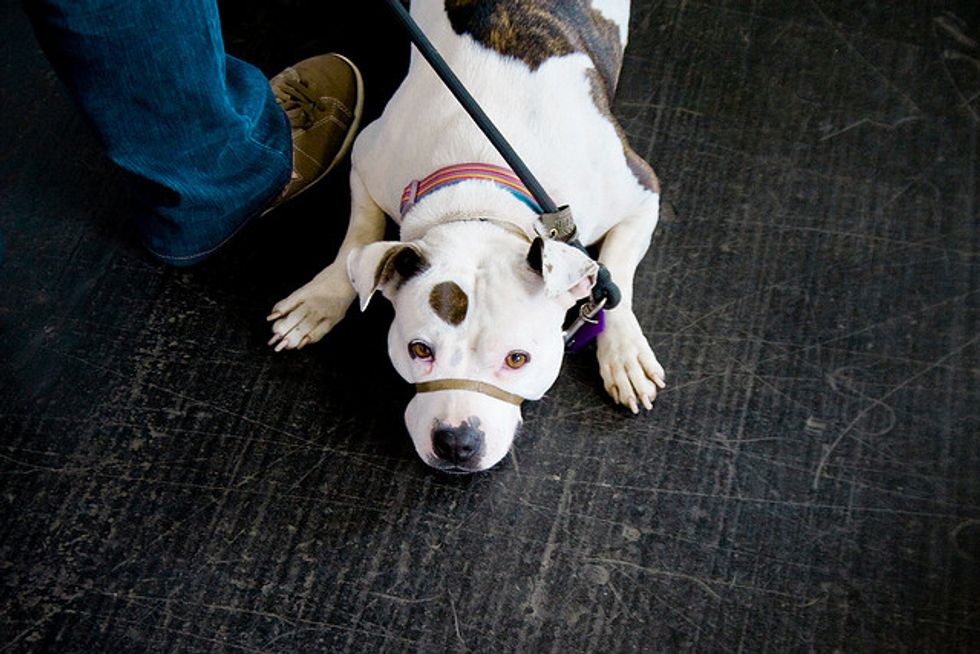Welcome to our weekly 'Ask a Vet from the SF SPCA' feature on 7x7.com. Dr. Jeannine Berger, DVM, DACVB is a board certified veterinary behaviorist who counsels guardians whose pets’ issues are beyond the scope of training. Think of her as a pet shrink…at your service. Ask your own questions in the comments!
If you saw our post last week about off-leash aggression, you may have said to yourself, “But my dog is aggressive on-leash.” Here is the post for you and your pup:
Why Dogs Bark & Lunge On Leash at Other Dogs on Walks
Does your dog whine, bark, growl, or lunge when he sees another dog while he’s on leash? This unpleasant but common behavior problem in dogs can be caused by what we call “barrier frustration.” By nature, dogs are strongly motivated to greet one another. Being on a leash prevents your dog from expressing this natural inclination, which may cause your dog intense frustration and over time result in barking and lunging. The restrictive barrier in this case is the leash, but can also be something like a window, fence, or gate. In essence, the dog’s frustration has amplified to a point where he can’t help his reaction.
On-Leash Aggression vs. Off-Leash Aggression
Though leash aggression can look vicious, it generally disappears when the leash comes off and the dog meets other dogs off leash. If your dog shows aggression toward other dogs when meeting off leash, then that is serious aggression and doesn’t fall into this category of behavioral diagnosis.
What You Can Do About It
Stay calm. Use a happy tone when approaching on-leash dogs—stay calm, but aware. Be prepared to move away quickly if needed (duck behind a car or cross the street) from the other dog. Keep the leash loose, if possible. If you seem tense or uneasy and tighten the leash, your dog will sense your unease and may respond by pulling and barking.
Use a humane training collar. A Head halter such as the Gentle Leader and Halti or a front buckle harness such as Sensation or Easy Walk harness makes on-leash management much easier and doesn’t hurt your dog. Choke, pinch, and shock collars, on the other hand, are punishment tools that cause pain and discomfort. We don’t recommend them for this or any behavior issue. The dog might stop barking because it hurts, but the pain won't decrease his frustration. In fact, keep in mind that the association with pain can cause or worsen aggression.
Play the “Find it” game. Have a handful of yummy treats and tell your dog, “find it,” and throw a treat in front of him as you pass another dog on the street. Continue to say, “find it,” and throw treats until you are safely past the other dog. This exercise distracts your dog from other dogs by keeping him focused on treats. Instead of staring at the other dog, your dog’s eyes will be searching for treats. And eventually, your dog will associate the sight of other dogs with yummy food.
Take a class. We offer reward-based behavior modification classes, called Reactive Rover, for dogs that are leash reactive. Sign up for Reactive Rover on our website and enter code 7x7 for a 10% discount.
Tips:
• If you haven’t done so already, spay or neuter your dog.
• If your dog is friendly and social off leash, provide him with daily off-leash play with other dogs. Make point of letting him off leash to play as a reward for sitting first. This can greatly reduce on-leash frustration.
• If you can’t take a class and your own efforts aren’t successful, contact us at the SF SPCA. I am a board-certified veterinary behaviorist and my team and I can find a game plan to solve your pet’s behavior issues. Don’t live in the Bay Area? Search locally for a veterinary behaviorist (Dip ACVB), a Certified Applied Animal Behaviorist (CAAB or ACAAB), or a Certified Professional Dog Trainer (CPDT).



















